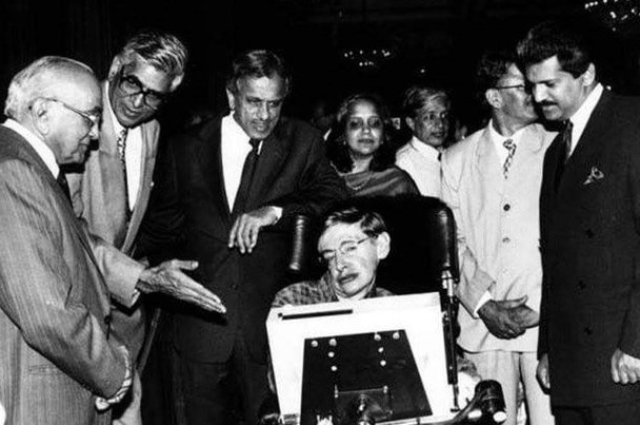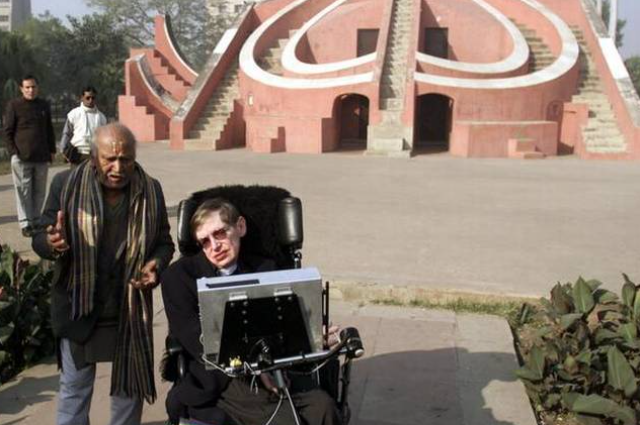
The whole world knows about Stephen Hawking, and he is one of the most famous scientists of our era. This legend proposed the incredible black hole theory, with many other astronomical and scientific reports. He also wrote several best-selling books, and the most famous of which was ‘A Brief History of Time’. People around the world know that how great a scientist he was, but very few of them know that when Hawking was diagnosed with a disease, two Indian scientists helped him cross a problematic hurdle in his journey.
Stephen Hawking was diagnosed with Lou Gehrig’s disease at the age of 21. It was a motor neuron disease also known as Amyotrophic Lateral Sclerosis (ALS). Yet that did not stop him, and he explored the mysteries of the Universe right from his wheelchair, and it started the human race’s great expedition to make a sense of our existence. At the age of 59, in January 2001, Stephen Hawking traveled to India and gave lectures and visited his favorite places. He had earlier also visited India in 1959 and thus, it was not his first-time visit to this country.

While Stephen Hawking was traveling in India, the Mahindra group created an exclusively equipped outfitted minivan for Hawking’s visit to Mumbai so he could travel conveniently within the city. He was given a tour of Mumbai in this special vehicle from the Mahindra group that could accommodate his wheelchair. Professor Stephen Hawking spent much of his life in a wheelchair, gradually losing control over his muscles due to ALS.
Hawking’s met with software engineers Arun Mehta and Vickram Crishna in Mumbai. In this meeting, they realized that there is a need to develop a better AI interface that could help Hawking type and speak that would make it easier for him to express himself. Consequently, Arun Mehta and Vickram Crishna came up with a software eLocutor for Stephen Hawking. It had predictive language software that would learn from Hawking’s habits over time, allowing him to type only pieces of words to get full sentences.
The software of eLocutor functions on a prediction pattern and strives to predict what a user is going to type next and reads from what he or she had already categorized in the past. It allowed Hawking to select the words he wanted to say, even with limited mobility. Yet, this eLocutor had to have hardware that Hawking and his assistants could work with, and tech giant Intel Cooperation helped to modify this model. With that, Stephen Hawking got his first custom-built computer. This eLocutor made it possible for Hawking to type and speak using a single button. After helping Professor Stephen Hawking, Arun Mehta and Vickram Crishna continued helping other people with disabilities.

This entire event made a huge impact on Stephen Hawking’s life because it made it possible for him to type and speak using just a button! It also had a huge impact on Hawking’s ability to continue working on a subject of science and technology that has had such a thoughtful influence on all of us. As he was able to talk with this technology and share his abundant knowledge about mankind and the universe, all we can remember are some lines from one of his speeches, which states,
"For millions of years, mankind lived just like animals. Then something happened which unleashed the power of our imagination. We learned to talk and we learned to listen. Speech has allowed the communication of ideas, enabling human beings to work together to build the impossible. Mankind’s greatest achievements have come about by talking, and its greatest failures by not talking. It doesn’t have to be like this. Our greatest hopes could become reality in the future. With the technology at our disposal, the possibilities are unbounded. All we need to do is make sure we keep talking".
During Stephen Hawking’s visit to India, he also met with the then President KR Narayan at Rashtrapati Bhavan in Delhi. At that time, he said, “Indians are so good at mathematics and physics”. According to a 2001 report by The Hindu, Hawking was very impressed by Indian mathematical genius and the theoretical physicist also expressed his wonder at this phenomenon and said it seemed to be a national characteristic.

During his visit, Stephen Hawking also traveled to New Delhi’s Qutub Minar, Jantar Mantar, Red Fort, and Humayun’s Tomb. His excitement for these visits led him to write to Javed Abidi, the then Honorary Director, National Centre for Promotion of Employment for Disabled People (NCPEDP) about making these iconic structures accessible to the disabled. The letter was passed to the Archaeological Survey of India. Temporary wooden ramps were installed at all 4 monuments, and it was hence pushed to making the monuments accessible to the disabled, almost overnight...!
Soon after the visit of Hawking, the then Tourism Minister Ananth Kumar announced grand plans to make all World Heritage Sites in India, including the Taj Mahal, accessible to the disabled. While this was something that the disabled in India had been demanding for many years, things only happened swiftly with Stephen Hawking’s visit. When Stephen Hawking visited India, he was given the first Sarojini Damodaran Fellowship by the Tata Institute of Fundamental Research. He also delivered a series of lectures. In Mumbai, he addressed an international physics seminar at the Tata Institute. Stephen also delivered a lecture at the Albert Einstein Memorial in Delhi. India embraced Stephen Hawking and a huge number of Indians were eager to hear what he had to communicate through something which two Indian scientists had made.
______________________________________________
Reference:
- www.timesofindia.com
- www.scroll.in
- www.theory.tifr.res.in
- www.thehindu.com
- www.wikipedia.org
